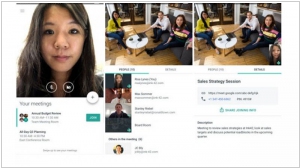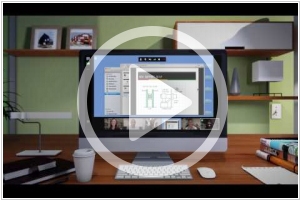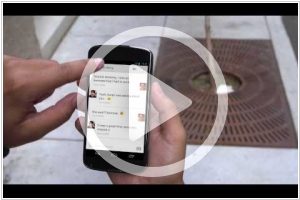Google Meet is #4 in Top 10 Videoconferencing software
(Formerly Google Hangouts) Video meetings for your business. Connect with your team from anywhere. With easy-to-join video calls, you can meet face to face without the added cost of travel.
Positions in ratings
#4 in Top 10 Videoconferencing software
#3 in Top 14 Video Calling apps
Alternatives
The best alternatives to Google Meet are: Skype, Zoom, Microsoft Teams, Google Chat, Facetime
Latest news about Google Meet
2022. Google Meet gets automatic meeting transcriptions
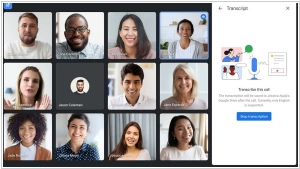
Google has introduced automatic meeting transcriptions as a built-in feature for its video conferencing service, Meet. Previously, users had to rely on third-party services like Otter to record and transcribe their calls. This new functionality is currently available for meetings conducted in English, with support for French, German, Spanish, and Portuguese slated for release in 2023. It's worth noting that Microsoft Teams already introduced a similar feature for English meetings over a year ago. Although Google possesses expertise in speech-to-text services through products like Assistant and the Android Recorder app, the addition of this feature to Meet has been a long-awaited development. Nevertheless, it is a welcome addition to enhance the meeting experience within Meet.
2022. Google Meet’s new feature lets users consume YouTube and Spotify together
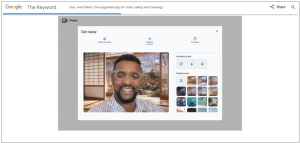
Google has recently announced the addition of live-sharing features, similar to Apple SharePlay, to Google Meet. This update aims to enhance collaboration during video calls by allowing participants to engage with content simultaneously in real-time. It's worth mentioning that Google had previously introduced live-sharing features, such as watching YouTube videos together, in Duo back in February. Now, with the integration of Duo into Meet, these features are being extended to the Meet platform. With the new live-sharing functionality, users will have the ability to watch YouTube videos collectively. These exciting features will be accessible through the Activities tab, which also includes options for Q&A sessions and polls, and can be found in the three-dot menu.
2022. Google Duo to unite with Google Meet
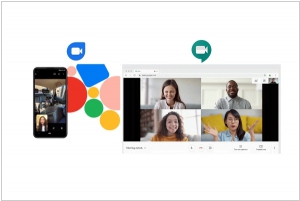
Google Duo, the consumer-focused video chat service by Google, is set to merge with Google Meet, the video chat service designed for business users. In this upcoming transition, the Duo app will incorporate all of Meet's features, including the ability to schedule calls. Subsequently, the Duo app will be rebranded as Google Meet, and the existing Meet app will seamlessly transition to the new combined Duo/Meet app. Although the process may appear complex, it is understandable considering the significant undertaking of migrating millions of users to the unified platform.
2021. Google Meet gets a refreshed UI, multipinning, autozoom and more

Google has introduced a significant update to its video-meeting service, Google Meet, incorporating a range of user interface enhancements for desktop users and introducing several new features. Noteworthy additions include multipinning, allowing users to highlight multiple feeds instead of just one, and new AI-driven video capabilities for light adjustments, autozoom, and a Data Saver feature that restricts data usage on slower mobile networks. For presenters who prefer not to view their own video feed, Meet now enables minimizing or hiding of their own feed. Additionally, users have the option to pin their own feed alongside other participants on the grid, providing the opportunity to briefly glance into their own eyes during the meeting.
2020. Google brings Meet to Gmail on mobile
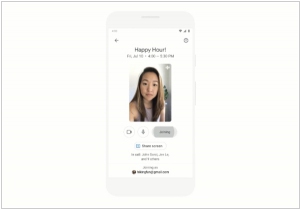
Google has recently integrated its Meet video conferencing service directly into the mobile version of Gmail. Users of Gmail on Android or iOS now have the convenience of joining Meet meetings directly from their inbox when someone sends them a Meet event link. This eliminates the need to install the dedicated Meet app solely for joining calls via Gmail. Within the Gmail app, a new Meet tab will appear at the bottom of the screen. This tab will display all upcoming Meet meetings from Google Calendar, allowing users to initiate a meeting, obtain a shareable link, or schedule a meeting within the Calendar. If you prefer not to have the Meet tab visible, you also have the option to disable it.
2020. Google Meet takes on Zoom by going completely free for everyone
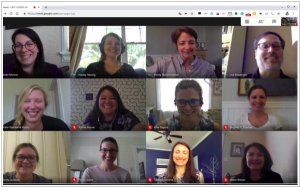
Google has made an announcement stating that its premium videoconferencing software, Google Meet, will now be offered for free to all users. Previously, Meet was exclusively accessible through Google's G Suite, a service package designed for businesses, with a starting price of $6 per month per person. However, it will now be accessible to anyone with a Google account. Google plans to gradually expand availability over the upcoming weeks, prioritizing the maintenance of a secure and reliable user experience. The free version of Meet will impose a time limit of 60 minutes on meetings, although Google will not enforce this limitation until after September 30. In comparison, the free version of Zoom imposes a 40-minute time limit on video calls. The free version of Meet also imposes other restrictions, such as a maximum of 100 participants, whereas the paid version supports up to 250 participants. Additionally, recording and saving calls are only available with the paid version.
2020. Google Meet adds Zoom-style gallery view

Google is introducing a gallery view, similar to Zoom, to its video-chat product, Google Meet. It's important to note that this service is not available for free to all Google account holders like Hangouts. Instead, it is a paid enterprise service primarily designed for businesses. Access to Google Meet starts at $6 per month, per user for the most affordable G Suite tier. The "most popular" version is priced at $12 per month, per person. Essentially, you are paying a premium for a feature that competing platforms like Zoom provide at no cost.
2020. Google is rebranding Hangouts services
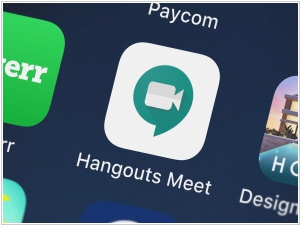
Google has made a significant change to its enterprise G Suite offering by officially rebranding Hangouts Chat as Google Chat and Hangouts Meet as Google Meet. With this move, the Hangouts brand is no longer associated with the enterprise-focused services. However, Google will retain the Hangouts name for its consumer chat app, which was originally created as a successor to Gchat and emerged from Google's discontinued social network, Google+, in 2013.
2017. Google Hangouts Meet provides new $1,999 hardware kit
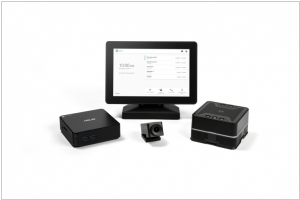
Hangouts Meet, Google's platform for conducting video and audio meetings, is receiving an array of new hardware components in its latest kit. This kit encompasses a touchscreen controller, a speaker microphone, a 4K camera, and an ASUS Chromebox, which serves as the central control device. Google has been offering various meeting kits based on Acer and ASUS Chromeboxes for some time, ranging in price from $999 to $1,999. However, with the division between Hangouts Meet and Chat (which is still somewhat perplexing), this new kit is specifically designed for Hangouts Meet and G Suite Enterprise edition customers. It also introduces the inclusion of a new touchscreen controller, although it is not the first touchscreen device tailored for Hangouts meetings. Google explains that the touchscreen is a 10-inch MIMO Vue capacitive display with HDMI capture, typically valued at around $499 when purchased separately from the kit.
2016. Google acquired work chat Pie
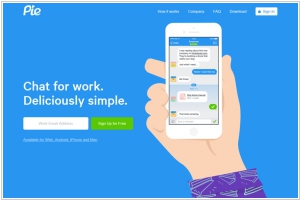
Google has acquired Pie, a team communication service similar to Slack, originating from Singapore. Pie aimed to differentiate itself in a crowded market that included well-funded rivals like Eko and ChatWork by offering a simplified experience tailored to non-technical companies. This acquisition is primarily an acqui-hire, meaning that Google is bringing onboard the talented team behind Pie. The purpose of this acquisition is to bolster a new Google team dedicated to developing products specifically for Southeast Asia, mirroring Google's successful approach in India over the past year.
2015. Google Hangouts now allows to make videocalls to those who don't have Google account
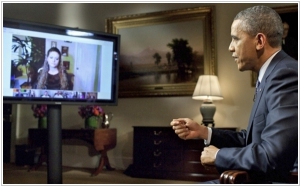
Google now offers the capability to invite individuals as "guests" to participate in a Hangouts meeting, regardless of whether they possess or desire a Google account. This advancement simplifies and streamlines communication, particularly in the context of video conferencing. The process itself is straightforward and hassle-free. To initiate, you only need to extend an invitation to the guests, who can then accept with a few taps or clicks. These guests will be identified as "external guests," and Google users can invite them to a Hangouts session through Google Calendar. Upon clicking the external link provided in the event description, guests are prompted to enter their name (preferably a professional one rather than a whimsical nickname). By completing these two simple steps, guests gain access to the meeting and can actively participate in discussions with you and other colleagues for the duration of the virtual gathering.
2015. Chat for work Pie gets $1.2M
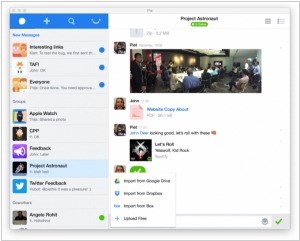
Enterprise messaging service Pie has successfully raised $1.2 million in Series A funding as it gears up to monetize its platform. Pie offers a comprehensive messaging service for teams, available on iOS, Android, Mac, and the web, with seamless integrations with Dropbox, Google Drive, Box, and other applications. It can be likened to a simplified version of Slack. Remarkably, the app has garnered usage from over 2,000 companies across various industries, ranging from marketing, advertising, and publishing to unexpected sectors like flower shops, manufacturing plants, universities, and even churches. With the recent funding secured, the company is preparing to introduce a paid version of the app. This premium offering will include administrative controls and will be priced at $3.14159 per user per month.
2014. Google Hangouts is available as a standalone Chrome app for Windows and Chromebooks
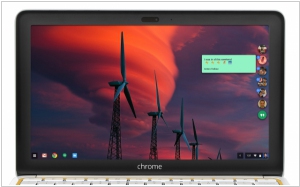
Users of Google Hangouts can now engage in chats and make calls directly from their desktops, eliminating the need to open a separate browser. Google Hangouts has been transformed into a Chrome app compatible with Windows and Chrome OS computers. Although installation on Mac OS X computers with Chrome is possible, full support is not yet available. This app conveniently provides access to all ongoing chats on the desktop. What's even more significant is the inclusion of voice call support within the app, enabling users to make calls directly from their computers. Additionally, Google Voice users will benefit from the integration of Voice with Hangouts, granting them access to voicemail and the ability to send and receive SMS messages.
2014. Google Hangouts adds voice calls to mobile app
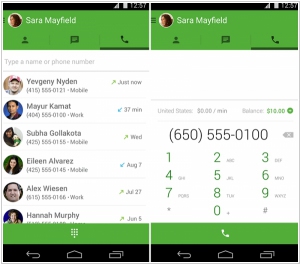
Google is continuing its efforts to consolidate its messaging services into a single application by integrating various Google Voice features, including free voice calling, into Hangouts. Android users can enjoy free voice calls after updating to the latest version of Hangouts, while web and iOS users gain immediate access to this feature. In addition, Hangouts users now have access to several Google Voice functionalities. Calls made through the Hangouts client will display the caller's Google Voice phone number as the caller ID, and incoming calls to that number will be automatically answered within the Hangouts app. Users will also be able to send SMS text messages through Hangouts, and Google Voice voicemail messages will seamlessly appear in Hangouts' conversation streams.
2014. Hangouts unlinked from Google+, becomes a part of Google Apps For Business
Until now, it was mandatory for Google Apps users to have a Google+ account in order to utilize Hangouts. However, as of today, this requirement has been eliminated. Users with a Google Apps account can now effortlessly initiate or participate in meetings using either their desktop or the dedicated Chromebox for Meetings device. Furthermore, Hangouts is being introduced to Google Apps for Business. While Hangouts was previously available to users on Google's paid accounts (subject to administrator permissions), this update ensures that Hangouts is now included under the same service level agreements (SLAs) as other Google services such as Gmail and Drive. Additionally, IT administrators have enhanced control over meetings directly from the Google Apps Admin Console, enabling actions like remote meeting initiation, muting, and conclusion.
2014. Google Hangouts will no longer require a plugin for Chrome
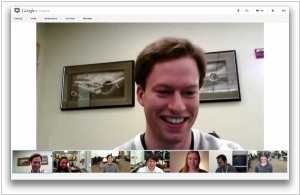
Starting next week, the video conferencing service Google Hangouts will be fully functional in Chrome without requiring the installation of any plugins. However, other Hangout-compatible browsers such as IE and Firefox will still rely on the plugin. Chrome, on the other hand, will have integrated support for Hangouts. With the ongoing shift towards HTML5, the emergence of new cross-browser protocols like webRTC, and even platforms like Unity aiming to become plugin-free, it will become exceedingly difficult to persuade users to install plugins in the future. Therefore, if your innovative concept relies on a plugin, it would be wise to explore alternative approaches.
2014. Pie - group collaboration chat with less noise
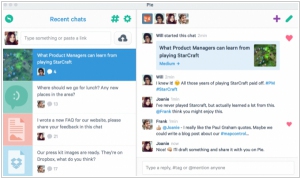
Pie, a group chat service, has recently secured nearly $1 million in funding as it aims to establish a presence in the enterprise collaboration market. In a competitive landscape that includes services like Slack, Convo, Hipchat, Hall, and CoTap, Pie sets itself apart through a distinctive approach. According to co-founder Pieter Walraven, their differentiation lies in providing a chat experience that is less cluttered and more focused on relevant topics, coupled with a simple and engaging design. Unlike traditional chat rooms that often deviate from the main subject and become noisy, Pie enables users to create mini-chatrooms dedicated to specific items such as links, files, questions, and images. This approach streamlines work chat by eliminating unnecessary noise and allowing for more targeted discussions.
2014. Google wants to embed its video chat in every business app
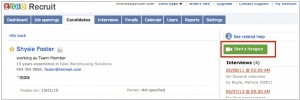
Google is making a serious effort to promote its video chat service, Google+ Hangouts, within the enterprise sector. In February of this year, they introduced a video conferencing system for meeting rooms using Chromebox. They also integrated Hangouts with renowned video conferencing systems like Polycom and Cisco. Furthermore, they recently launched a video chat plugin for Outlook. Now, Google is extending an offer to all developers of business apps, inviting them to embed the Hangout button into their products. This button enables users to initiate video calls instantly. Many developers have already embraced this opportunity. For instance, the Hangout button video is now accessible in various applications such as Salesforce CRM, Zendesk customer support app, Smartsheet project management system, Zoho Connect enterprise social network, Zoho Recruit recruiting software, and more.
2014. Google created Hangouts video chat plug-in for Outlook
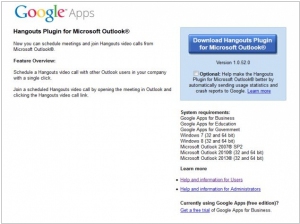
Instead of utilizing the native email solution, GMail, some Google Apps users have been relying on the desktop version of MS Outlook. However, these users have been lacking the ability to engage in chat and video calls, a feature available to GMail users. While there is an integration of Outlook with Microsoft Lync, companies using Google Apps typically do not deploy Microsoft Lync. To address this issue, Google has released the Google Hangouts plugin for MS Outlook. This plugin enables users to conveniently initiate video calls with their Outlook contacts, organize group video conference calls with up to 10 participants, and schedule video meetings within Outlook's Calendar. It is worth noting that Microsoft recently introduced Skype integration for Outlook.com, but this integration is limited to the online version of Outlook.
2014. Google Hangouts now can connect to Polycom, Cisco and other videoconferencing systems
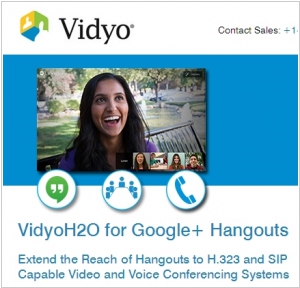
In a recent update, we covered Google's introduction of the video conferencing system for meeting rooms called Chromebox for Meetings. However, Google's ventures in this field don't stop there. It has come to light that Vidyo, the renowned provider of enterprise video communication systems, powers the backend infrastructure for Google Hangouts. Additionally, Vidyo has incorporated a new service called VidyoH2O into this backend, enabling Google Hangouts users to participate in video meetings with corporate videoconferencing systems such as Polycom, Cisco, Avaya, Lifesize, and others that support H.323/SIP standards. This opens up significant potential for establishing intercompany video meetings. It is important to note that this service is not offered for free and is priced starting from $99 per month per concurrent user.
2014. Google unveiled video conferencing system for meeting rooms

Enterprise video conferencing systems (like Polycom, Tandberg ...) cost tens and hundreds thousands of dollars, and their installation and maintenance - is a difficult task. On the other hand videochat services (like Skype, GoToMeeting ...) can't provide the effect of presence that will let business users to completely abandon trips. Therefore, gasoline and airline tickets are still among the the main expenditures in many companies. Google decided to fight this evil and launched the professional video conferencing system based on Google Hangouts - Chromebox for Meetings. It costs just $999 + $250/year (the subscription fee is paid starting from the second year). As you can understand from the title, the system is based on the Chromebox - Google's desktop computer running Chrome OS. In addition, it includes Logitech HD camera, microphone, remote control and any LCD TV. ***
2013. Voice calling is back in Google Hangouts
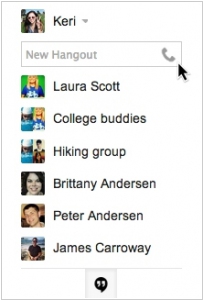
As you may be aware, following the merger of Google's communication services (Gmail Chat, Google Talk, and Google Hangouts), only Google Hangouts remained as the primary platform. However, one notable absence was the lack of a voice feature, leaving users without the ability to make VoIP calls within Gmail. This came as an unpleasant surprise to many users. Addressing this concern, Google has now added voice functionality to Hangouts after just two months. This means that you can now make internet calls from Gmail, Google+, and the Hangouts app for Chrome. The calls can be made between PCs or from a PC to a phone. Additionally, participants can be connected to Hangouts conferences through VoIP calls. It's important to note, however, that Google has not yet added voice capabilities to the Hangouts mobile apps for iOS and Android. For now, the calling feature is only available on desktop platforms.
2013. Google unites GTalk and Hangouts
Google's engineers are currently occupied with a multitude of tasks, particularly those related to Google Glass, which leaves little time for addressing other essential products. For several years, we have eagerly anticipated Google's integration of its various communication services, aiming to create a competitive alternative to Skype. Finally, after a few weeks of dedicated effort, they have made significant progress in this endeavor. Google Talk messenger has been replaced by Google Hangouts, a video chat service. Google has launched two mobile apps for Hangouts, available on Android and iOS platforms. Moreover, Hangouts can be accessed through Gmail and Google+. The beauty of Hangouts lies in its synchronized chat applications, allowing users to initiate conversations on their computers (via Gmail) and continue them seamlessly on their mobile devices while away from the office. The chat feature supports the insertion of pictures and videos from YouTube, while video chat can accommodate up to 10 participants simultaneously. Unfortunately, Google has not yet integrated Hangouts with Google Voice, which means SMS cannot be sent through Hangouts, and voice calls are not yet available. At present, users can choose between sending a message or making a video call, as voice calls are not supported within Hangouts.
2012. Google replaces GMail Video chat with Google Hangouts
Google should have long ago integrated its various chat, voice, and video services and applications. Finally, they have taken a simple yet effective step by replacing GMail's video chat with Google Hangouts. Both services utilize the same browser plug-in and authorization system. However, Hangouts offers a plethora of additional features, including free videoconferencing for up to 10 participants, screen-sharing, whiteboarding, collaborative editing of Google Docs, simultaneous co-watching of YouTube videos, webinars, and more. There is even a catalog of third-party apps that are compatible with Hangouts. Furthermore, Hangouts allows video calls not only to contacts within GMail but also to those on Google+, and it is available not only on browsers but also on Android, iPhone, and iPad devices. Google plans to roll out this new feature over a two-week period.
2012. Google+ Hangouts comes to iPad and iPhone

It's quite peculiar that Apple doesn't actively pursue the title of being the dominant video chat platform, and they even allow competitors to utilize their platform for this purpose. Despite the fact that it was Apple's iPhone that popularized mobile video chat and weakened Skype's position, Apple's own video chat application Facetime hasn't shown much progress, and competitors continue to utilize it. Just yesterday, Google launched a new Google+ app for iPad featuring the Hangouts video chat feature, and they also updated the Google+ app for iPhone to support Hangouts. As a reminder, Google Hangouts enables users to organize online video meetings with up to 10 participants, completely free of charge. Furthermore, Google's video chat is compatible with Android smartphones and tablets, as well as any computer through a web browser and a small plug-in.
2011. Google adds phone conferencing to Hangouts
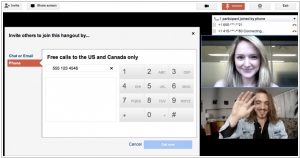
Skype's killer feature that propelled its immense popularity was undoubtedly video calling. The revenue generator for Skype is IP telephony. Google, however, was unable to replicate the same success with GTalk/GMail/Google Voice as people had already become accustomed to Skype. Nonetheless, Google aims to make strides with its rapidly expanding group video chat platform, Google Hangouts. Google's strategy involves integrating Hangouts with IP telephony. The new feature in Google Hangouts enables users to make calls to landlines and mobile phones, allowing individuals who are not currently at a computer to join online meetings. This integration is particularly crucial for business meetings, as it facilitates connecting clients or partners to the discussion. Presently, these external calls are limited to the United States and Canada and are free. However, it is highly likely that this functionality will soon be available in other countries through paid Google Voice calls.
2011. Google+ launched pages for companies and brands
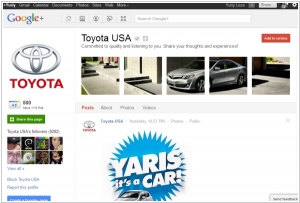
After Google opened its social network Google+ for Google Apps business users, it didn't make enterprises waiting for a long time with the next step. Today it added an opportunity to create pages for companies and brands, like on Facebook. Many companies have already done it. Here are examples of business pages: Toyota, Pepsi, FC Barcelona, Angry Birds. And though it's not possible to select vanity URLs yet, spend 5 minutes and create a page for your company right now. You can do it here: plus.google.com/pages/create. Company page in a social network - is a great way to make your business closer to your customers and partners (and to find new ones). Of course, meanwhile the Google + Pages are less functional than Facebook Pages: you can't publish RSS-feed, only one person can add messages, widgets for websites and apps are not ready yet. But there are two major benefits. ***
2011. Google Hangouts turned into full-featured web-conferencing tool
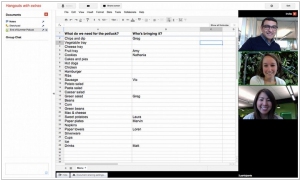
The ingenious hack developed by a Lebanese programmer, enabling text collaboration in Google+ Hangouts, didn't remain a hack for long. Today, with the latest Google+ update, Hangouts has received a plethora of exciting new features. Firstly, there's the addition of screen-sharing, allowing users to share their screens. Secondly, the ability to collaboratively draw on a whiteboard enhances the interactive experience. Thirdly, users can now collaborate on Google Docs documents directly within Hangouts. Fourthly, Hangouts allows for the creation of broadcasts with an unlimited number of viewers (while the number of active participants remains limited to 10). Fifthly, Google Hangouts video chat is now compatible with Android smartphones. And finally, sixthly, Google has officially opened the API for Hangouts, eliminating the need for hacks like the one developed by the Lebanese programmer, enabling users to create their own applications for Hangouts. By the way, Google+ social network is now open to everyone. Is your company prepared for this?
2011. Google Hangouts adds real-time code-collaboration
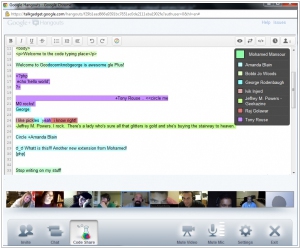
Mohamed Mansour, an open source software engineer, has developed an extension called Hangout Pad for Google+ that enhances Google+ Hangouts by enabling text collaboration, including the sharing of program code, during video chats. While this extension may still have some bugs, it is intriguing for several reasons. Firstly, it operates independently of the official Google+ API, which is yet to be released. Hangout Pad functions as a Google Chrome browser plugin, integrating with Hangouts video chat through a clever hack involving Google Shared Spaces and the Google Wave protocol. Nevertheless, it showcases the potential for expanding the capabilities of Google Hangouts and poses a challenge to competitors like Skype. The collaboration window, positioned above the user's video streams, can accommodate various content types. Moreover, it serves as an impressive demonstration of the future integration between Google Hangouts and Google Docs.
2011. GMail VoIP is available almost globally
The VoIP service in GMail, previously available only in the U.S. and Canada, is now accessible to users in nearly all countries worldwide, supporting 38 different languages. However, there are a few countries where Gmail Call Phone is currently not available, including Argentina, China, Cuba, Egypt, Ghana, India, Iran, Jordan, Kenya, Mexico, Morocco, Myanmar, Nigeria, North Korea, Peru, Russian Federation, Saudi Arabia, Senegal, South Korea, Sudan, Syria, Thailand, United Arab Emirates, and Vietnam. With this global expansion, Google has also reduced its VoIP rates, making them slightly more affordable compared to its main competitor, Skype. For instance, a call to France costs 8 cents (compared to 16.9 cents in Skype), and a call to the USA costs 1 cent (compared to 1.9 cents in Skype). Similar to before, using GMail Call Phone requires a quick installation of a browser plug-in, which is the same plug-in used for video calling in GMail.
2011. Web video chat: Google Hangouts vs Facebook Skype
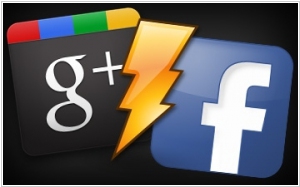
A great battle between Google and Skype (Microsoft) for the video calling market continues on a new platform - the Social Web. Last week Google launched (in Beta) their social network Google + and one of it's features is the group video chat Hangouts. And yesterday the built-in Skype-based video chat appeared in Facebook. Both video chat apps work directly in browser, which signals about the transition of video calling applications to web-technologies (although both apps require the installation of a small browser plug-in). ***
2011. Google adds video chat to Android. Skype already enables video calls between Android and iPhone

Earlier this year, we forecast the active competition between Skype and Google for the mobile video chat market. And the companies justify our expectations. Yesterday Google launched the (wireless) update of Android-smartphones, that adds voice and video chat to mobile Google Talk. At first Nexus S models will be updated, then all other devices running Android 2.3 and higher. Built-in video chat on Android will work via Wi-Fi, 3G, 4G networks, and will allow to call from a smartphone to GMail and back. Recall that the operating system for tablets Android Honeycomb already has in-built video chat. Meanwhile, Skype is already ahead of its competitor - it already offers video chat for Android and iPhone, and even lets you make video calls between these devices. ***
2010. Google improves video chat quality
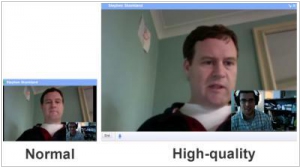
Despite Gmail video chat not reaching the same level of popularity as Skype and not generating revenue for Google, the company remains committed to its development. Notably, Christopher Vander Mey, Senior Product Manager for Google Apps, personally leads this effort. It suggests that Google has significant plans for incorporating video chat into the business environment. Further supporting this notion is the introduction of an enhanced video quality feature, now available in Gmail Labs. By enabling this feature, users can experience improved picture clarity, reduced CPU load, and even utilize a lower internet connection. Vander Mey attributes these advancements to Google's own development, specifically mentioning the use of hardware-accelerated video decoding technology based on H.264. It's important to note that this improvement is not a result of the GISP acquisition. To enable video chat in Gmail, users are required to install this plug-in.
2010. GMail = Unified Communications client
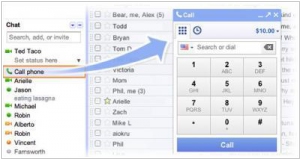
Few days ago the analytical company Frost & Sullivan stated that Google will soon storm the unified communications market, which is dominated by Cisco, Avaya and Microsoft. After all, Google has GMail, Google Voice, GTalk, Buzz, Gizmo5, Android, GISP and it remains just to combine all these technologies into single offering. And Google has decided to immediately confirm this forecast - from today GMail allows you to make and receive phone calls (thanks to the integration with Google Voice and Gizmo5). Meanwhile the VoIP service in GMail is available only in US. ***
2010. Google may outgo Skype by means of mobile video
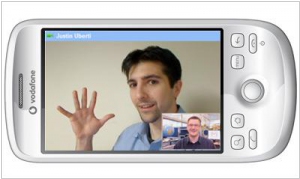
Video chat in GTalk (or more exactly, in GMail) has appeared more than a year ago. And we were confident that Skype will get the very strong competitor. Nevertheless, Skype's market share hasn't suffered at all. Even GMail users mainly continue using Skype for video calls. Probably, it's a question of a habit and Skype's great popularity. And perhaps, when Google adds calls to regular phones with the help of acquired Gizmo5 - this won't also change anything. Without offering some new revolutionary features, pushing Skype from the market will be extremely difficult. Especially now, when Skype introduced group video calling. However, it seems Google has a new idea. Today the company announced the acquisition of Swedish developer of VoIP and videoconferencing solutions - GIPS. GIPS technologies are used in Yahoo Messenger, Cisco WebEx and Lotus Sametime. And in addition, GIPS has created the best engine for video chat on Android. ***
2009. Google acquired Gizmo5
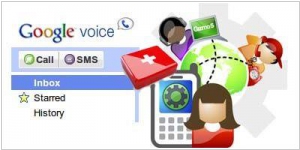
Multiple sources (including TechCrunch) say that almost exactly Google has bought Gizmo5 for $30 millions. If it's true, Skype now will get the very powerful competitor. Interesting, that month ago Skype was going to buy Gizmo5 itself in order to replace the Global Index technology (that was a reason of lawsuit) with Gizmo5 SIP-based platform. But now when Skype has after the Skype settlement, though, Gizmo5’s strategic value to Skype sort of plummeted. But, it turns out, that Gizmo5 has the strategis value to Google. And, really, it ideally fits Google's communication plans. First of all, GTalk can call only between internet users, but can't call PSTN and mobile phones. Gizmo5 will easily provide this opportunity to GTalk users. ***
2008. Google Adds Voice And Video Chat to Gmail
Google is launching voice and video chat for Gmail, directly competing with Skype, Meebo, and TokBox. Users can now engage in instant message conversations with the option to switch to video or voice chat by clicking on the "Video & more" menu in a Gmail chat window. The feature allows for full-screen viewing, adjustable window size, and positioning. With Gmail as a primary email platform, users no longer need to open a separate application for spontaneous text, voice, or video chats. This move aligns with Google's goal of seamlessly connecting its services while providing a better user experience. The addition of video chat within Gmail poses a challenge for startups specializing in video chat solutions. The feature originated from Google's acquisition of Marratech, an e-meeting startup, in 2007.
2008. Google brings text-messaging to online chat
Starting Thursday, Google will expand the instant messaging feature in Gmail, allowing users to send text messages to their contacts' phones. According to Gmail Product Manager Keith Coleman, users can access this feature by clicking on the chat window's settings or typing a contact's phone number in the chat contact search box. Initially an experimental feature available through Gmail Labs settings, Google will make it accessible on Thursday. Gmail Labs serves as a testing ground for new features, with several popular options such as attachment reminders, customizable flags, chat pictures, and QuickLinks. However, Google plans to refine and test these features further before incorporating them into the standard Gmail application. It's important to note that the Gmail text-messaging feature is exclusive to Gmail and does not work with other Google messaging options. Behind the scenes, text messages are sent from a specific Google phone number, reserved for this purpose, and each pair of users retains that number for future communication. The recycling of phone numbers is feasible since most users are unlikely to exceed 1,000 text-message chat contacts.
2007. Google Talk And Windows Live Messenger 9 Get Friendly
It appears that the various instant messaging (IM) programs have finally realized the need to consolidate, which users have been aware of for some time. Microsoft has made progress by enabling Live Messenger 9 (currently in private testing) to communicate with Google Talk, and they are also working on integrating AIM and ICQ. Considering that Live Messenger 8 already connects with Yahoo Messenger, we may be approaching the launch of a polished, officially released messenger hub. It raises the question of why it took the companies so long to pursue this. Trillian has been available for quite a while, although it doesn't facilitate communication between different IM platforms, it does consolidate them to reduce memory usage. Personally, I am delighted to see IM programs finally collaborating, as it becomes tiresome to have multiple programs open every day.
2007. AIM on Gmail Chat Now Live
Gmail and AIM have finally implemented unified chat by utilizing the Open AIM framework. The integration, which was announced earlier this month, is now live. When you sign into your AIM account through Gmail chat, your AOL buddies will be displayed in your chat list alongside your Google Talk friends. AIM contacts will be identified by the signature yellow guy next to their screen names, and they will be unaware that you are not signed into AIM. To enable this feature, you need to adjust your settings on Gmail under the Chat tab. It appears that the new functionality has not been universally rolled out yet, so it may not be visible to everyone. If you're eager to check if you have the new integration, try logging out and signing back in. Google has been preparing for AIM integration by adding group chat and emoticons, indicating their intention to enhance the chat experience. Additionally, with the introduction of color-coding options for Gmail, Google's interface is becoming more vibrant and lively.
2006. Google offers hosted productivity apps
Starting next week, organizations will have the opportunity to provide their members or employees with a range of Web-based services for free, courtesy of Google. The beta version of Google Apps for Your Domain is now available, offering Gmail with 2GB of storage, Google Calendar, Google Talk, and Page Creator. This new service builds upon the previously launched beta version of Gmail for Your Domain, which allows organizations to use Gmail applications with their own customized email addresses. The existing Gmail for Your Domain service already boasts an impressive user base, including tens of thousands of active domains, hundreds of thousands of users, and numerous registered universities. With Google Apps for Your Domain, organizations can outsource their communication applications to Google, customize the user interface to reflect their branding and color scheme, and utilize an English-language web-based control panel for managing user accounts, aliases, and distribution lists. Additionally, a premium edition with support and extra storage will be introduced later this year, although specific details have not been disclosed.
2006. Google merges Gmail with chat
Google was poised to launch Gmail Chat on Monday, a feature that enables users to send instant messages directly from their email accounts with a single click. Users can also view the online status of their contacts and save chat histories similar to email messages. The Quick Contacts list in the application synchronizes with a user's Google Talk friends list and automatically displays the most frequently contacted people along with their online status. Clicking on an online contact opens a chat window in the browser. Users can save chat history for easy searching and select an "off the record" option to prevent the conversation from being saved. Gmail Chat is compatible with Internet Explorer 6.0 and higher, Firefox 1.0 and higher, and is currently available in the U.S. English interface. While Google Talk's chat functions are integrated into Gmail, users need to download the Google Talk client application to make voice calls. In the U.S., Gmail ranks fourth among web-based email programs, and Google Talk is the seventh most popular instant messaging program, according to Nielsen/NetRatings. Other competitors like Yahoo Mail and AIM Triton also offer integrated messaging and voice features.

